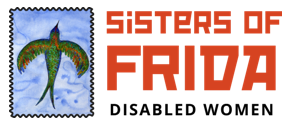

Bringing disabled women together, mobilising
and sharing through lived experiences
Disabled Women: the invisible majority
 In discussion tonight, some members of Sisters of Frida discussed two blogs written on the occasion of International Women Day.
In discussion tonight, some members of Sisters of Frida discussed two blogs written on the occasion of International Women Day.
The first by Mary Keogh in Disability and Human Rights – International Women’s Day: Women with disabilities a dichotomy in protection.
She writes:
Women with disabilities often remain invisible in mainstream laws and policies for women. A contributing factor to this invisibility is a general lack of data disaggregated from a gender and disability perspective. In addition, research concerning the issues faced by women with disability is still in its early stages, leaving women and girls with disabilities invisible citizens in mainstream policy, often not considered in the mainstream disability movement and well as the women’s movement. Even within the Convention on the Elimination of Discrimination Against Women (CEDAW), a mainstream women’s movement, women with disabilities are notably absent. While CEDAW has obligations for achieving equality between men and women, the prohibitions on discrimination against women do not explicitly make reference to women with disabilities. Yet, women with disabilities are the largest minority among the female population and disability is a category that crosses all other categories including gender, race, age, orientation, and religion.
She continues:
Some progress has been made to increase the level of visibility on women with disabilities. The Convention on the Rights of People with Disabilities (CRPD), which has been ratified in a number of nations worldwide, includes an article specifically addressing the rights of women with disabilities (Article 6). This article recognizes that women and girls with disabilities are subject to multiple discrimination, and asks States to ensure that women and girls with disabilities are given the opportunities to enjoy their fundamental rights and freedoms. Article 8 also addresses matters pertaining to the rights and protections of women with disabilities, and addresses awareness raising to combat sex-based stereotypes, prejudices, and harmful. Article 16, while addressing freedom from violence, exploitation, and abuse includes several provisions on gender issues.
Laws and policies are just one piece of the puzzle that will lead to the promotion of equal opportunities for women with disabilities. The development of education and awareness programs can also help to challenge the stigma faced by women with disabilities. On this celebratory day, States that have signed and ratified the CRPD must ensure that they are working to implement its specific provisions in order to achieve progress for women with disabilities. Equally States that have signed and ratified CEDAW must consider the rights of women with disabilities.
(Read the complete article at Mary Keogh’s blog.)
We are happy to say that Sisters of Frida have been working with the UK CEDAW working group to add disabled women in the next CEDAW shadow report.
But Mary Keogh is right. In the next blog, A happy International Women’s Day surprise: Government commits to signing Istanbul Convention on violence against women, Scarlet Harris writes:
I got a nice International Women’s Day surprise when I woke this morning to the news that Nick Clegg had announced in a speech in the Hague last night that:
“On the eve of International Women’s Day, I’d like to express the UK’s support for the principles in the Council of Europe’s Convention on Violence Against Women and Domestic Violence. A landmark agreement aimed at lifting the standards of protection for women across Europe. We are getting ourselves in a position to sign later this year”
She says:
I will however point out that this commitment is all the more important given the context of cuts to women’s VAWG services, cuts to legal aid, and cuts to various housing and social benefits that offer a lifeline to many women living in refuges and rebuilding their lives after escaping a violent relationship.
She mentions:
Sylvia Walby’s excellent report on the impact of the cuts on VAWG services makes for sobering reading. It reports that 230 women were turned away by Women’s Aid on a typical day in 2011 due to lack of space, that specialist BME services are being forced to close, the number of Independent Domestic Violence Advisers (IDVA) has been reduced, and that statutory provision, including those police and court services that involve specialised expertise, has also faced cuts.
The interim findings of Vera Baird QC’s Commission into how cuts are impacting on women’s safety were published yesterday and paint a gloomy picture of street lights being turned out, police numbers cut, refuges closing their doors, transport staff cut, legal aid cuts, housing and social benefits cut, and women fleeing domestic violence being advised to sleep on park benches or to seek a bed in A&E.
Neither of these reports really mention disabled women in much detail. We should ask the question why? As Mary Keogh points out- women with disabilities are the largest minority among the female population and disability is a category that crosses all other categories including gender, race, age, orientation, and religion.
Happy International Women’s Day!
